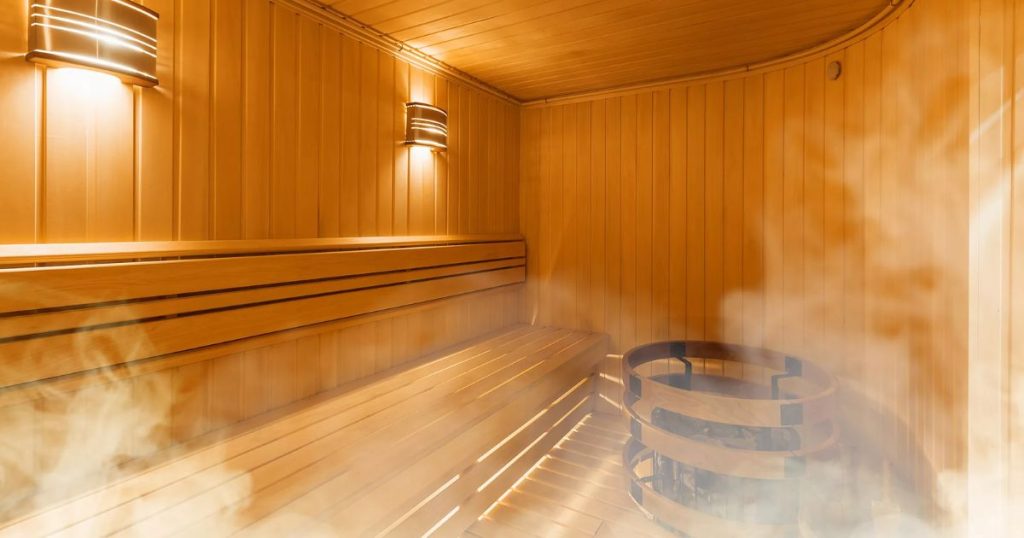When it comes to the sauna experience, temperature plays a crucial role in determining the intensity and benefits you receive. Different types of saunas offer varying temperature ranges, catering to personal preferences and desired outcomes.
Let’s explore the various sauna temperature ranges to help you find your perfect match.
Traditional Finnish Sauna Temperatures (140°F – 200°F)
Ah, the traditional Finnish sauna! Feeling like a true Finn? Crank it up to 200°F (93°C) and immerse yourself in an authentic Finnish experience. These saunas typically range from a comfortable 140°F (60°C) to a sweat-inducing 200°F, heated by either a wood-burning stove or an electric heater topped with sauna rocks to retain the heat.
Infrared Sauna Temperatures (100°F – 125°F)
Infrared saunas offer a gentler warmth, enveloping you like a heated blanket. These saunas use infrared heaters to directly warm your body, rather than heating the air around you.
The temperature range for infrared saunas is typically between 100°F (38°C) and 125°F (52°C), allowing for longer, more comfortable sessions.
Steam Sauna Temperatures (110°F – 120°F)
Step into a steamy oasis with a steam sauna. At temperatures ranging from 110°F (43°C) to 120°F (49°C) and 100% humidity, the steam will have you dripping with relaxation. The combination of heat and moisture opens your pores, promoting detoxification and soothing muscle tension.
More Post:
Orangetheory Capture the Flag Workout – OTF Workout Today
Factors Affecting Your Perfect Temp

While temperature ranges provide a general guideline, finding your perfect sauna temperature is a personal journey influenced by various factors:
Body’s Heat Tolerance: Some individuals have a higher tolerance for heat, while others may find intense temperatures overwhelming. It’s essential to start at a comfortable level and gradually work your way up to higher temperatures as your body acclimates.
Mood/Reason for Saunaing: Your desired outcome can influence the ideal temperature. For example, if your goal is detoxification, a higher temperature may be more beneficial. However, if you seek relaxation, a moderate temperature might be more suitable.
Personal Preference: At the end of the day, the “best” temperature is whatever feels right for you. Some sauna enthusiasts prefer the intense heat, while others enjoy a more gentle warmth. Trust your body’s signals and adjust the temperature accordingly.
Pro Tip – The Rule of 200
The Rule of 200 is a handy guideline for achieving the perfect sauna environment. It states that the sum of the sauna’s temperature (in degrees Fahrenheit) and humidity percentage should equal approximately 200. For example, at 180°F (82°C) and 20% humidity, you’d have the perfect 200 combo for a balanced sauna experience.
- If you prefer a drier heat, prioritize a higher temperature with lower humidity.
- For a more humid, steamy session, opt for a lower temperature with higher humidity levels.
Use this rule as a starting point, but don’t hesitate to experiment and find the combination that works best for your preferences and goals, whether it’s a post-workout detox or a relaxation night.
Duration Guidelines
Just as important as temperature is the duration of your sauna session. Here are some general guidelines for different sauna types:
- Traditional Saunas: 10-20 minutes
- Infrared Saunas: 20-30 minutes
- Steam Saunas: 10-15 minutes
Remember, these are just guidelines, and your personal tolerance may vary. Always listen to your body’s cues and exit the sauna if you feel dizzy, lightheaded, or uncomfortable. Proper hydration and taking breaks as needed are essential for a safe and enjoyable experience.
Maximum Safe Temps
While saunas offer a range of temperatures, it’s crucial to understand the maximum safe limits to avoid potential health risks:
- Traditional Saunas: Up to 195°F (91°C)
- Infrared Saunas: Up to 140°F (60°C)
- Steam Saunas: Up to 125°F (52°C)
Exceeding these maximum temperatures can lead to hyperthermia, a potentially dangerous condition where your body’s temperature rises to unsafe levels. Always prioritize safety and never push your body beyond its limits.
Frequently Asked Questions
What is the best sauna temperature?
There is no single “best” temperature that suits everyone. The ideal temperature depends on the type of sauna, your personal heat tolerance, mood, and preference. For traditional Finnish saunas, a good starting range is 150°F (66°C) to 180°F (82°C).
Is 70 degrees too hot for a sauna?
No, 70°F (21°C) would be quite cool for any type of sauna and unlikely to produce the desired heating effects. Most saunas operate at much higher temperatures to provide therapeutic benefits.
Is a 200-degree sauna too hot?
While 200°F (93°C) is at the upper limit for traditional Finnish saunas, it may not necessarily be “too hot” for individuals with a high heat tolerance. However, it’s essential to start at lower temperatures and gradually work your way up to avoid discomfort or potential health risks.
Is 60 degrees Celsius hot enough for a sauna?
Yes, 60°C (140°F) is a typical lower temperature for an authentic Finnish sauna experience and provides excellent therapeutic heat benefits. Many sauna enthusiasts find this range comfortable and enjoyable.
Conclusion
Finding your perfect sauna temperature is a journey of self-discovery, balancing personal preferences, goals, and physical tolerance. Remember, the key to an enjoyable sauna experience lies in listening to your body and adjusting the temperature accordingly.
Start at a comfortable level, experiment with different temperatures and humidity levels, and gradually work your way up as you become accustomed to the heat. Don’t be afraid to mix things up and try different sauna types to find the one that resonates most with you.
Embrace the warmth, relax your mind and body, and let the sauna work its magic. Whether you seek detoxification, pain relief, improved circulation, or simply pure relaxation, the perfect sauna temperature awaits you. So, step inside, adjust the heat to your liking, and embark on a journey of rejuvenation and blissful self-care.

I founded the sports news website SportRevUp in 2022 to deliver breaking news and in-depth analysis on major leagues like the NFL, NBA, and MLB.
With years of experience reporting on professional sports, I created an ad-free platform for engaging coverage and discussion as editor-in-chief overseeing all content strategy.
I continues developing SportRevUp to provide sports fans the news and discussion they crave about favorite teams and athletes.
